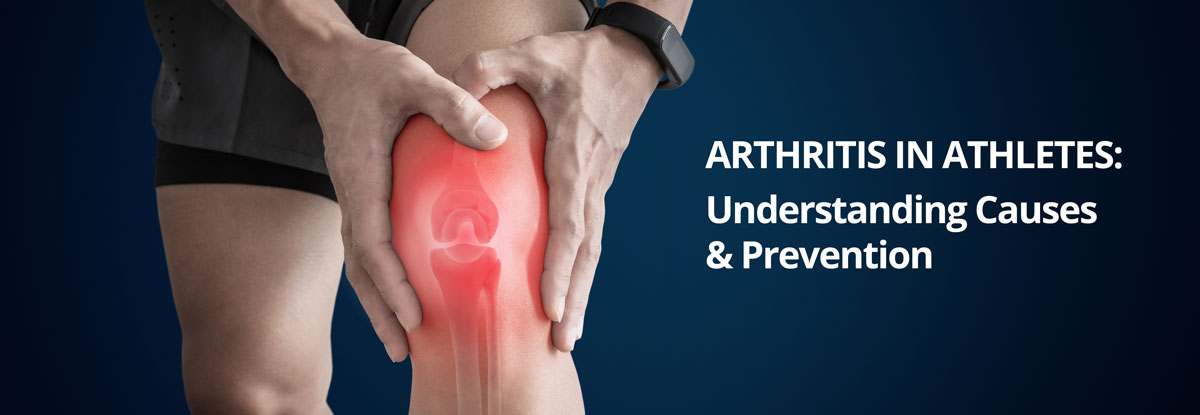While athletes often epitomize health, strength, and vigor, they are not immune to medical ailments, including arthritis. The constant wear and tear on their joints can sometimes lead to chronic conditions that can impact their performance and daily life. Here we delve into the relationship between athleticism and arthritis, looking at the types of arthritis, causes, management strategies, and preventive measures.

Types of Arthritis in Athletes
Arthritis refers to inflammation of the joints, causing pain and disability. While there are over 100 different types of arthritis, a few are more prevalent in athletes due to the nature of their activities.
Osteoarthritis (OA): This is the most common form of arthritis in athletes. It is a degenerative condition where the cartilage that cushions joints breaks down over time. It predominantly affects weight-bearing joints like knees, hips, and ankles, especially in sports that involve repetitive motion or impacts.
Rheumatoid Arthritis (RA): An autoimmune condition, RA is less common but can affect athletes. The body’s immune system mistakenly attacks its tissues, affecting the lining of the joints, leading to painful swelling and eventual joint deformity.
Post-traumatic Arthritis: This form develops following a sports-related injury. It can set in after fractures, ligament injuries, or severe sprains. It’s similar to OA in its symptoms but is directly linked to an injury.
How Can Sports Contribute to Arthritis?
The relationship between sports and arthritis is multifaceted:
Repetitive Strain: Sports that involve repetitive motions, such as running or cycling, can lead to joint wear and tear over time, accelerating the degradation of protective cartilage.
Direct Injuries: A direct injury to a joint can increase the risk of developing arthritis in that joint. For instance, an ACL tear can increase the chance of knee osteoarthritis.
Overuse: Pushing the body beyond its limits can lead to overuse injuries. Over time, these micro-injuries can cumulatively increase the risk of arthritis.
Lack of Recovery: Insufficient recovery and rest between strenuous activities can deprive the joints of the necessary healing time, making them more susceptible to arthritis.
Ways Athletes Can Manage Arthritis
Even if arthritis sets in, it doesn’t mean the end of an athletic journey. With the right strategies, athletes can manage the condition:
Physical Therapy: A trained physical therapist can develop exercise routines that strengthen the muscles around the affected joints, enhancing stability and reducing pain.
Anti-Inflammatory Medications: Nonsteroidal anti-inflammatory drugs (NSAIDs) can be beneficial for temporary relief from pain and inflammation. Always consult with a healthcare professional before starting any medication.
Weight Management: Carrying excess weight increases stress on weight-bearing joints. Maintaining a healthy weight can reduce arthritis-related pain.
Joint Protection: Using braces or supports can provide additional joint protection during athletic activities. Custom orthotics can also distribute weight more evenly and provide cushioning.
Stay Active: While it might seem counterintuitive, staying active can help manage arthritis. Low-impact exercises like swimming or cycling can maintain joint function without excessive strain.
How Can Athletes Reduce Their Risk of Arthritis?
Prevention is always better than cure. While not all arthritis cases are avoidable, certain measures can reduce the risk:
Proper Technique: Ensuring the correct form and technique in any sport or exercise is crucial. Poor form can lead to undue stress on joints.
Cross-Training: Instead of focusing solely on one activity, incorporate various exercises into the regimen. This not only reduces the risk of repetitive strain injuries but also ensures overall joint health.
Adequate Rest: Ensure you get adequate rest and recovery between sessions. This is when the body heals and repairs itself.
Warm-Up and Cool Down: A proper warm-up prepares the joints for activity, while cooling down helps in recovery and reduces muscle stiffness.
Stay Hydrated: Joint cartilage is mainly water. Staying hydrated aids in maintaining its spongy nature, reducing the risk of wear and tear.
Regular Check-ups: Regular health check-ups can identify potential issues early on, allowing for timely interventions.
Diet: A balanced diet rich in omega-3 fatty acids, antioxidants, and vitamins can support joint health.
Avoid Excessive Training: Overtraining can quickly lead to injuries. Listening to the body and knowing when to slow down is crucial.
Whether you’re a professional athlete or a weekend warrior, staying active in sports does come with its risks, including the potential for arthritis. However, with informed choices, proper training techniques, and a keen ear to the body’s signals, athletes can reduce their risk and ensure a long, fulfilling sporting journey. If you’d like to learn more schedule an appointment with one of our Orthopaedic Sports Medicine Experts today!